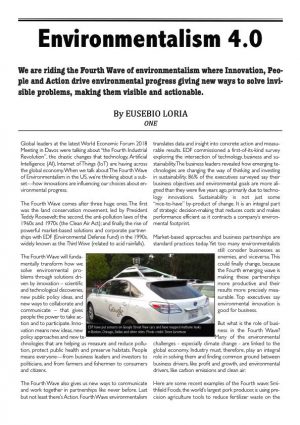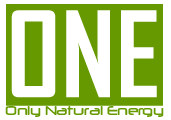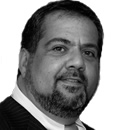 Global leaders at the latest World Economic Forum 2018 Meeting in Davos were talking about “the Fourth Industrial Revolution”, the drastic changes that technology, Artificial Intelligence (AI), Internet of Things (IoT) are having across the global economy. When we talk about The Fourth Wave of Environmentalism in the US, we’re thinking about a subset — how innovations are influencing our choices about environmental progress.
Global leaders at the latest World Economic Forum 2018 Meeting in Davos were talking about “the Fourth Industrial Revolution”, the drastic changes that technology, Artificial Intelligence (AI), Internet of Things (IoT) are having across the global economy. When we talk about The Fourth Wave of Environmentalism in the US, we’re thinking about a subset — how innovations are influencing our choices about environmental progress.
The Fourth Wave comes after three huge ones. The first was the land conservation movement, led by President Teddy Roosevelt; the second, the anti-pollution laws of the 1960s and 1970s (the Clean Air Act); and finally, the rise of powerful market-based solutions and corporate partnerships with EDF (Environmental Defense Fund) in the 1990s, widely known as the Third Wave (related to acid rainfalls).
The Fourth Wave will fundamentally transform how we solve environmental problems through solutions driven by innovation – scientific and technological discoveries, new public policy ideas, and new ways to collaborate and communicate – that gives people the power to take action and to participate. Innovation means new ideas, new policy approaches and new technologies that are helping us measure and reduce pollution, protect public health and preserve habitats. People means everyone — from business leaders and investors to politicians, and from farmers and fishermen to consumers and citizens.
The Fourth Wave also gives us new ways to communicate and work together in partnerships like never before. Last but not least there’s Action. Fourth Wave environmentalism translates data and insight into concrete action and measurable results. EDF commissioned a first-of-its-kind survey exploring the intersection of technology, business and sustainability. The business leaders revealed how emerging technologies are changing the way of thinking and investing in sustainability. 86% of the executives surveyed say their business objectives and environmental goals are more aligned than they were five years ago, primarily due to technology innovations. Sustainability is not just some “nice-to-have” by-product of change. It is an integral part of strategic decision-making that reduces costs and makes performance efficient as it contracts a company’s environmental footprint.
Market-based approaches and business partnerships are standard practices today. Yet too many environmentalists still consider businesses as enemies, and viceversa. This could finally change, because the Fourth emerging wave is making these partnerships more productive and their results more precisely measurable. Top executives say environmental innovation is good for business.
But what is the role of business in the Fourth Wave? Many of the environmental challenges – especially climate change – are linked to the global economy. Industry must, therefore, play an integral role in solving them and finding common ground between business drivers, like profit and growth, and environmental drivers, like carbon emissions and clean air.
Here are some recent examples of the Fourth wave: Smithfield Foods, the world’s largest pork producer, is using precision agriculture tools to reduce fertilizer waste on the network of farms that supplies the company with corn. It’s part of Smithfield’s goal of 25 percent cutting supply-chain greenhouse gas emissions by 2025. The company is the first in its industry to set such a target, and its progress is enabled by corn growers increasing investment in tools that help determine the most efficient ways to apply fertilizer. Levi Strauss & Co. just announced a new digital manufacturing capacity that automates part of the jeans production process, allowing the company to tailor supply to meet demand, reducing textile waste and eliminating thousands of chemicals previously needed for finishing.
EDF have put sensors on Google Street View cars and have mapped methane leaks in Boston, Chicago, Dallas and other cities. Google Earth Outreach has also mapped the air pollution threats to West Oakland, block by block, providing local citizens with high-resolution data that strengthens the emission cut policy according to the new state air quality law. Oil and gas facilities owned by Statoil, PG&E, and Shell have installed methane detection units after warning entrepreneurs to find cost-effective and new solutions to help operators identify leaks on distribution lines. EDF is just one of many groups doing this kind of work. Walmart, Unilever, and Nestle are also working with IBM to explore “blockchain” applications for food supply chains.
The advantage for the environment is less food waste. For business, this approach increases supply chain efficiencies and ensures food safety. World Resources Institute is using satellites to track Amazon deforestation and uploading data on a website that can alert local authorities to fires; companies are implementing “blockchain” processes to improve traceability and accountability across supply chains from verifying the sustainability of Indonesian tuna supply chains to managing energy trading across solar-powered microgrids. There is a great promise on the oceans where fishing boats can be coordinated and monitored remotely. Some fisheries are testing technology that will count and classify a boat’s catch with cameras tied to machine learning. All these actions can prevent overfishing and illegal fishing while at the same time protecting critical food sources.
In April, EDF announced plans to develop and launch a new satellite that will be built to locate and measure methane emissions from sources worldwide, starting with the oil and gas industry. Free and open data from this satellite will give countries and companies data to recognize problem areas, identify savings opportunities, and measure their progress in reducing methane emissions over time.
Sensors, machine learning, IT, data analytics are used to shape smart policy. They are the prerogative of business and the environment. The result will be a positive change that helps people and nature to stand up straight on the crest of the Fourth Wave.
Eusebio Loria

